In Storia dell’Arte in Parma (2020) Maddalena Spagnolo elegantly and effectively sketches a chapter, Nel segno di Leonardo (In the Sign of Leonardo), where she finds the afflatuses of Vinci’s genius spilling over into the Po Valley lands and decisively channeled onto the singular painter born in Correggio (1489) who “arrived in the city in his early thirties” and then went on to accomplish memorable feats here. For the author, the link between the two is obvious and it would be inconceivable to deny it, so that critics can now bring themselves very close to David Alan Brown’s seminal thesis The young Correggio and his Leonardesque Sources, written in 1973 and which then seemed a fairly “sideways” endeavor within the general art literature.
Scrolling through Brown’s thesis, but also following the highly mobilized youthful stages of the Allegri all intent on collecting every datum of the exploding renaissance, one can conjecture a web of encounters that become gradually more credible today. The debutant Correggio becomes the prized pupil of the Dynasty regent of his native place, which in some of its members accompanies him and presents him in many places, and from which Count Nicolò II (poet, dramatist, master of delights) departs continually, called to the northern Courts for all kinds of festivities and celebratory occasions. So Modena, Ferrara, Venice, Mantua, and Milan are soon touched by Correggio, and it is in the Sforza capital that Nicolò is Leonardo’s great confidential friend, his costumier of the continual festivals and carnivals that enjoy the direction of the Correggio count. The latter writes an insinuating sonnet to his painter friend, where he plays on his nominal attribute (Tu Vinci tutti!) but where he exhorts him not to amuse himself when he paints, otherwise (he tells him with a very significant pouring out) you will always paint yourself! It is well possible that Nicolò (+1508) first brought Antonio Allegri to Leonardo’s studio and in front of his placed works.
Regarding Parma, we cannot simply consider Correggio’s coming “from outside”; indeed, the city had been home for two centuries to a branch of the Correggio comital family, which had also ruled there and hosted Petrarch here. In addition, the daughters of “da Correggio” were brides to nobles from the city and nearby castles. Apparently, one of Antonio’s maternal aunts was also married in the city. So our Antonio was well at home there where the stream divided “this side” and “that side” of the water, and he was familiar with its cultural and artistic ferments.
To strengthen the plot of a continuous flow, ideal but also tangible, between Correggio, Mantua, Milan and Parma, soon entered Veronica dei conti Gàmbara, already the friend and literary guest of Isabella d’Este Gonzaga, who became Countess of Correggio from 1508. Falling at that time was the heartfelt negotiation between Isabella and Leonardo to have from the admired genius a tablet painted with a Christo giovenetto de anni circa duodeci, to which the Marchioness of Mantua supremely aspired. It is not improper to think that a very few years later (1510-1511) Antonio Allegri made those two astonishing small panels with such a subject, urged on by Veronica; nor to think that the lady of Correggio sent at least the most talking one to Isabella. Out of curiosity we will say that the painting in question, now in Washington, was long believed to be by Leonardo himself. From this sending may hold the conjecture of the spare arrival at Correggio’s court of Mantegna’s Redeemer that still illuminates the local museum.
Brown’s thesis thus touches on a phenomenon that now appears undoubtedly central to art history. Michelangelo and Raphael by the first two decades of the sixteenth century had already reached truly absolute expressive and formal heights. How to paint better than Raphael? How to extract from marble powers and wonders more than Michelangelo? Indeed, the broad phenomenon of Mannerism testifies to this problematic block between skills and languages. But the mighty river of the constituents of Italian art found in Leonardo’s heritage and legacy the very wide bend of an unforeseen and extraordinarily fruitful continuity that traveled on the backdrops of emotional naturalness, on the physical laws of mobility and phenomenal visibility, on the deepest and most inductive theology, on the attempted transfiguration of an entire space. Such a new verb came from the northern experiences of Leonardo and passed to that very happy young painter, predisposed and sunny, who came from Correggio.
At the beginning of this 2021 the Association of Friends of Correggio and the Lions Club of Correggio wanted to underscore their cultural commitment by producing an Italian translation of David Alan Brown’s thesis, thus honoring the great scholar friend and at the same time highlighting the historical role of Antonio Allegri, who just five hundred years ago placed in the Palazzo dei Principi of his hometown the stupendous portrait of Countess Veronica, magnificently exemplified on Leonardo’s Mona Lisa. An international streaming conference on Feb. 25 crowned the presentation of the translation, with Prof. Brown speaking directly. The event was joined by the Lions Clubs of the Emilia-Liguria District. To show the contents of the thesis, and the consequent televised treatment, we show here with figures some exemplary titles of rapprochement between the two greats: Leonardo the master and Correggio the brilliant son. This is an almost didactic way, but certainly (given the feedback received) very receptive. As D. A. Brown, Correggio never copies Leonardo, never tries to counterfeit him as did “the Milanese” his followers, but instead captures his masterly teachings and the incomparable “effect of grace.” Correggio, who visited Leonardo again around 1512, always retained his intimate inspirations: thus remaining himself he opened the new paths of the arts, in Italy and Europe.
Note: Those who would like computer translations of David Alan Brown’s essay (without the notes) should contact < giuseppe.adani@alice.it >
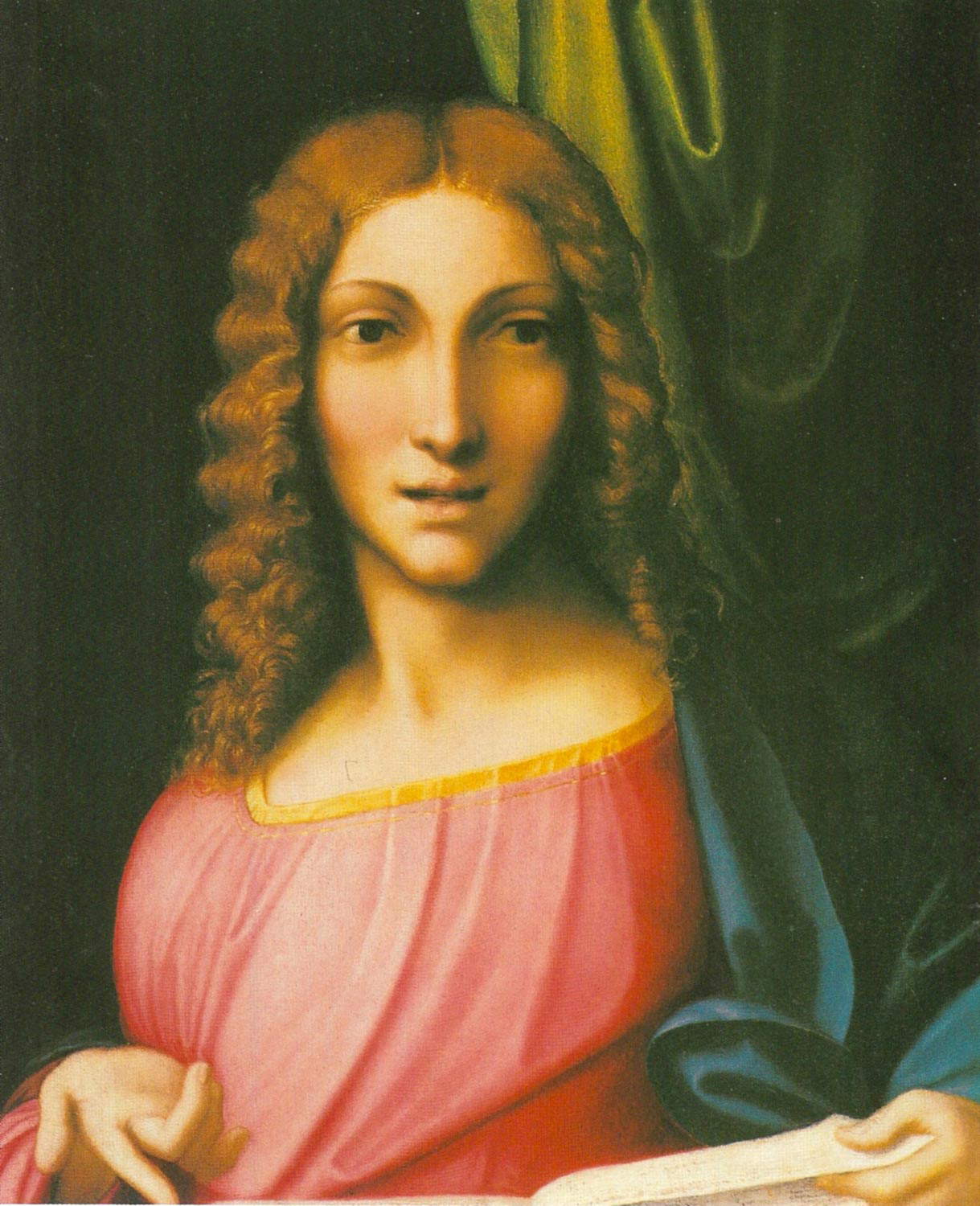 |
| Correggio, Young Christ (oil on panel, 42.6 x 33.3 cm; Washington, National Gallery of Art) |
 |
| Andrea Mantegna, The Redeemer (tempera on canvas, 55 x 43 cm; Correggio, Museo Civico) The young Correggio makes the emblematic icon that Isabella was expecting from Leonardo. Indeed, the small panel was once believed to be by Leonardo himself. Mantegna’s Redeemer testifies to the relationship between Correggio’s court and that of Mantua. |
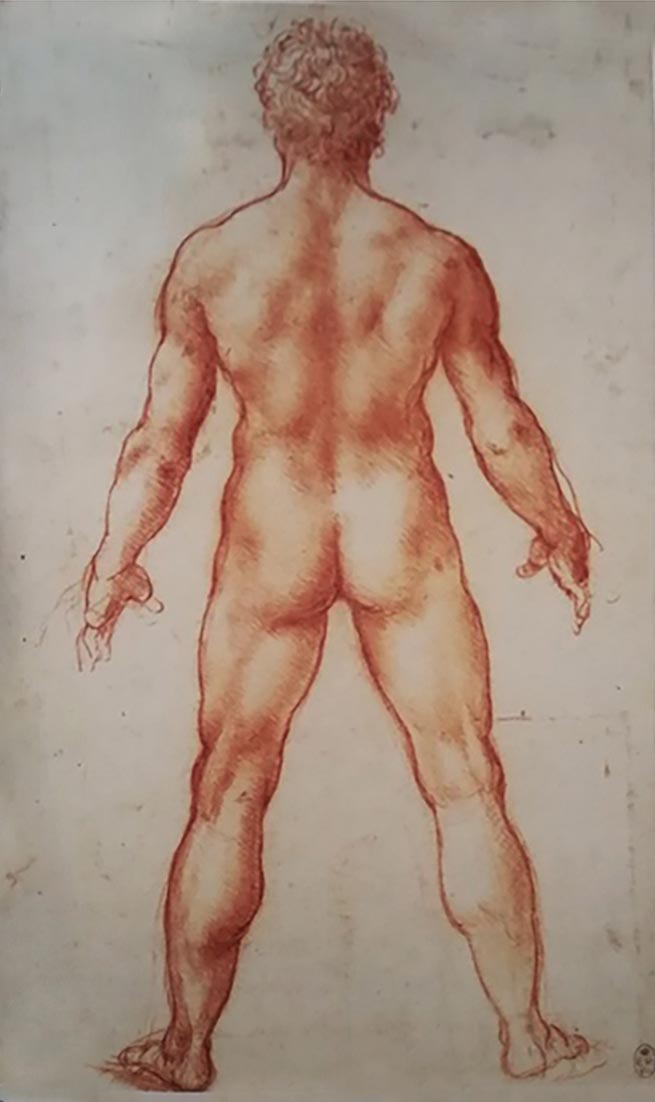 |
| Leonardo, Drawing of a Man (sanguine; London, Royal Library) |
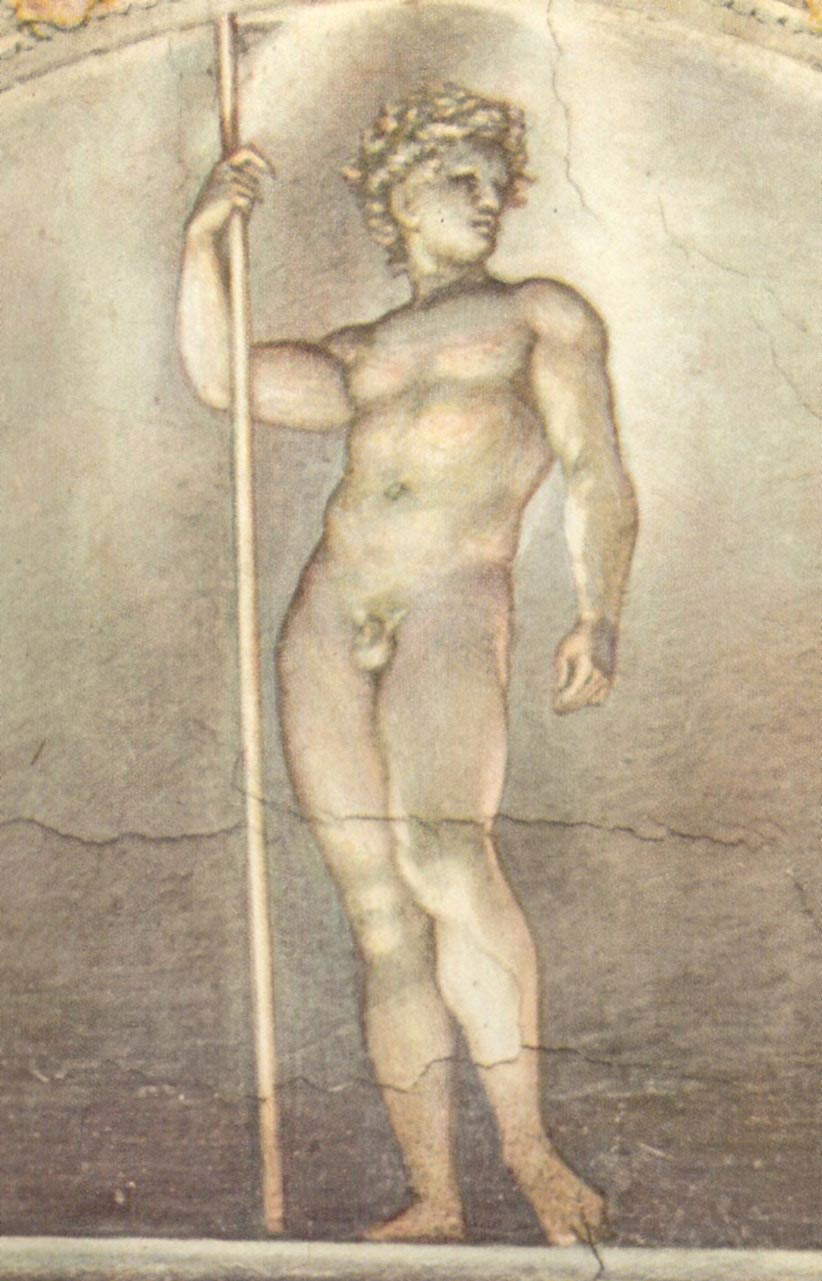 |
| Correggio, The Hero (1518; fresco; Parma, Camera di San Paolo) The certain possession of the human figure is the stigma of every great artist. Leonardo draws in the very first hand not a model, but a living, quivering man. He will bring his “possession” to the apax of the Vitruvian Homo, demonstrating him to be the fulcrum of all harmony, canonical and geometric. Correggio, with equal confidence lays out his Hero, crowned with oak according to ancient Latin usage: also an emblematic figure of the full Renaissance and a prelude to the celebrated nudes of the domes. |
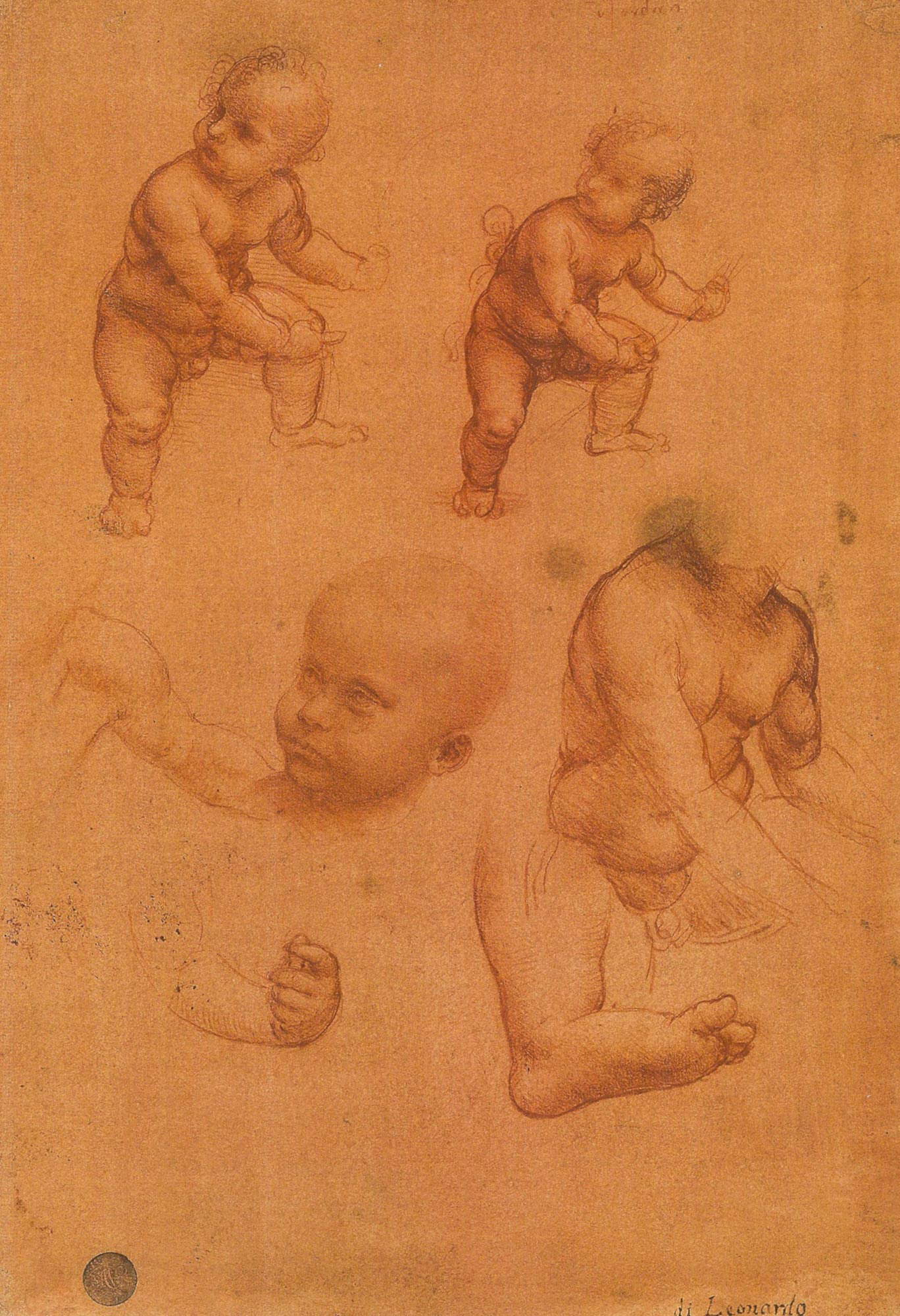 |
| Leonardo, Drawing of Children (Venice, Accademia Gallery) |
 |
| Correggio, Putto with Garland and Triumph of Love (Switzerland, Private Collection) Leonardo’s intense love of childhood is sustained by many valuable drawings and observations, where the mimic centrality blends suavely with the scientific, punctual character of the master. For his part, the young Correggio immediately devoted himself to children, forever choosing sanguine drawing in the footsteps of Leonardo. Here the soft child is pictured under a beautiful Love Chariot, like those that Count Nicolò had prepared for magnificent courtly feasts. In the Camera di San Paolo, Allegri would soon lay out the “puerile decus” with thirty-six nude putti, which we will later find in all the frescoes. |
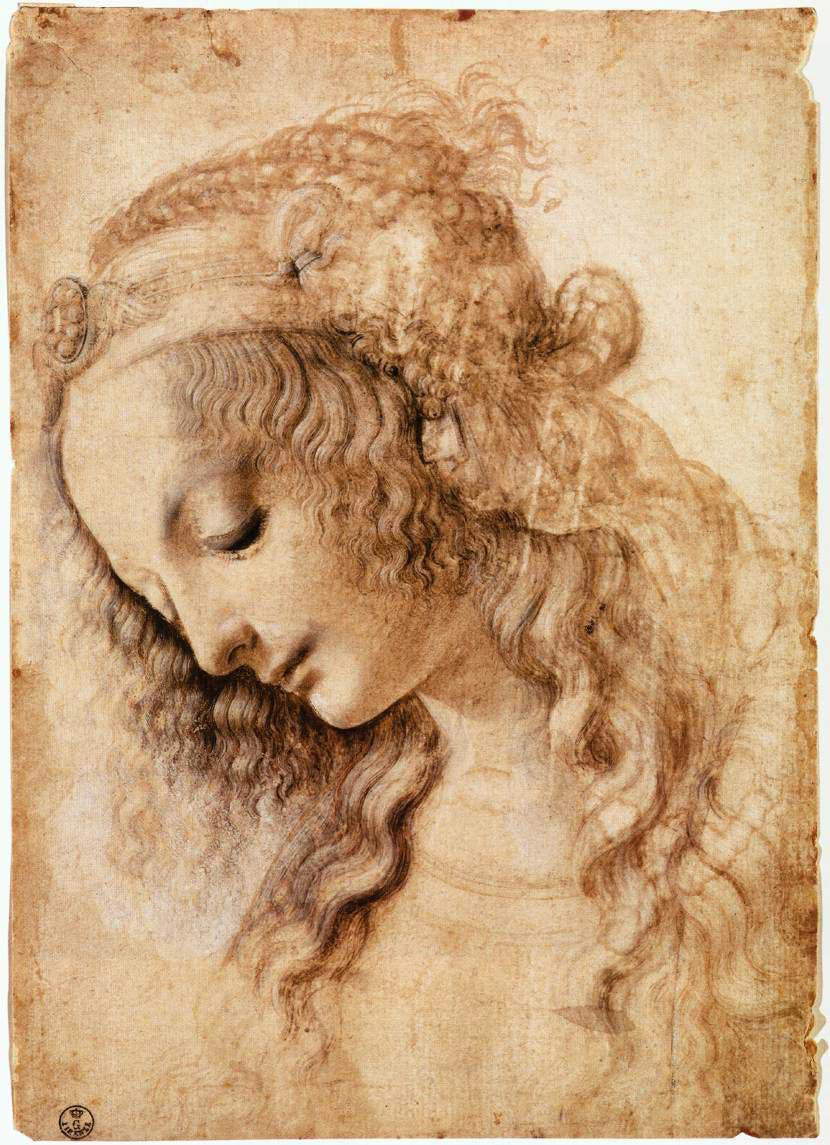 |
| Leonardo, Face of a Maiden (drawing executed in Verrocchio’s workshop; Florence, Uffizi Gallery, Gabinetto dei Disegni e delle Stampe) |
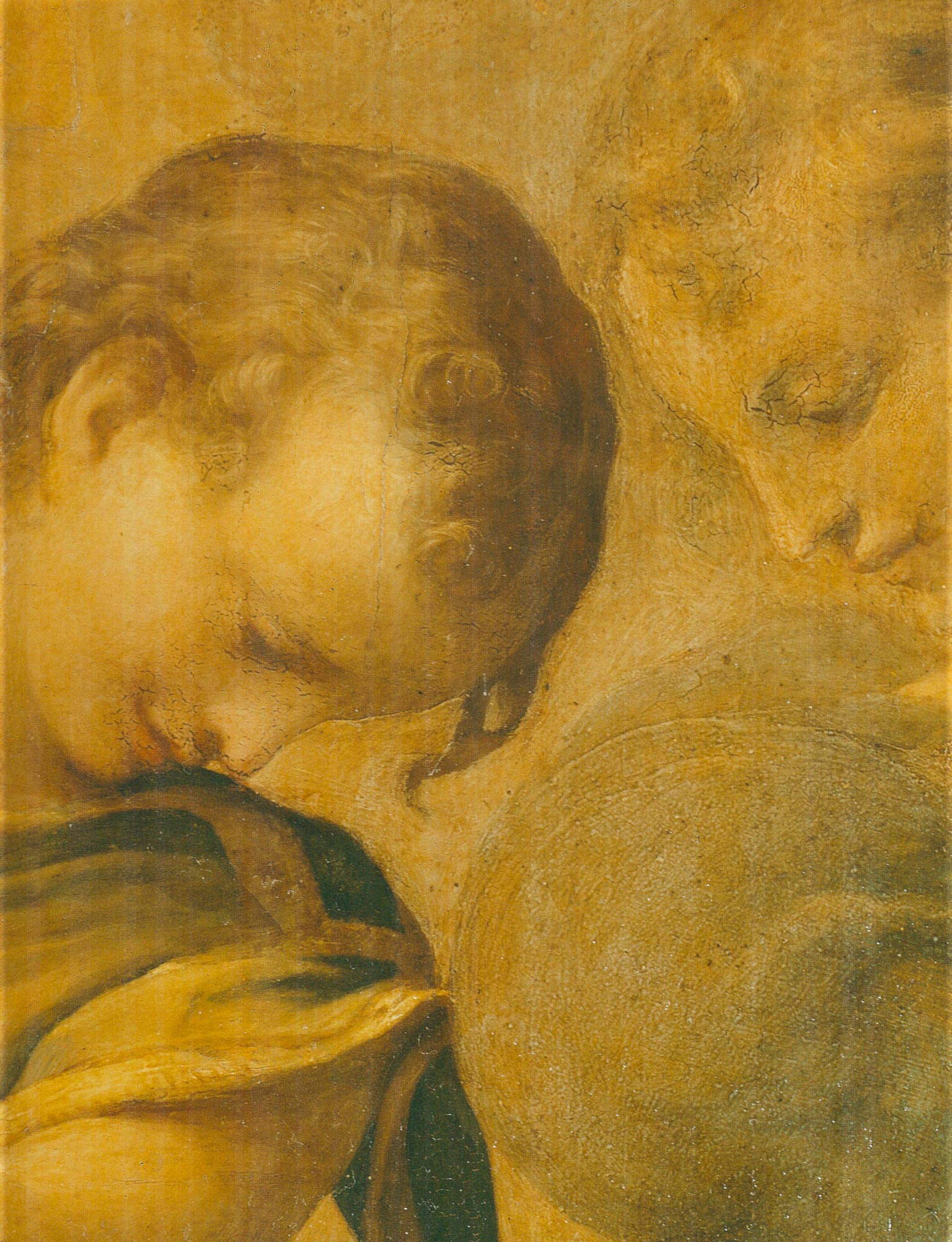 |
| Correggio, The Angels in the Altarpiece of Saint Sebastian (oil on panel; Dresden, Gemäldegalerie) Famous and impressive is Leonardo’s diuturnal research into the expression of faces, the mirror of the soul: a theme that can condense every dedication, every sigh, every achievement of the artist’s figurative life, to the point of making each portrait a breathy imbrication of spirituality. Leonardo thus drew several maiden heads, well mindful of Florentine stiacciato. Correggio fully understands such a quest by wanting to dematerialize celestial entities to hold them in suspended, sweet veils. |
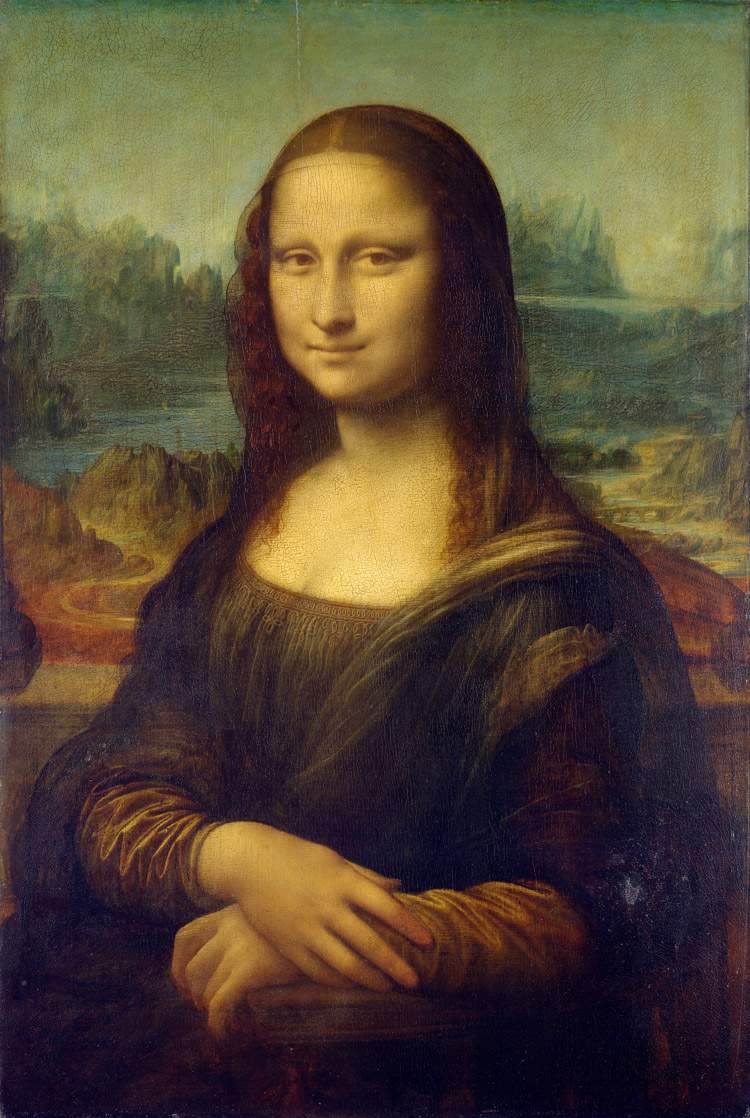 |
| Leonardo da Vinci, La Gioconda (c. 1503-1513; oil on panel, 77 x 53 cm; Paris, Louvre) |
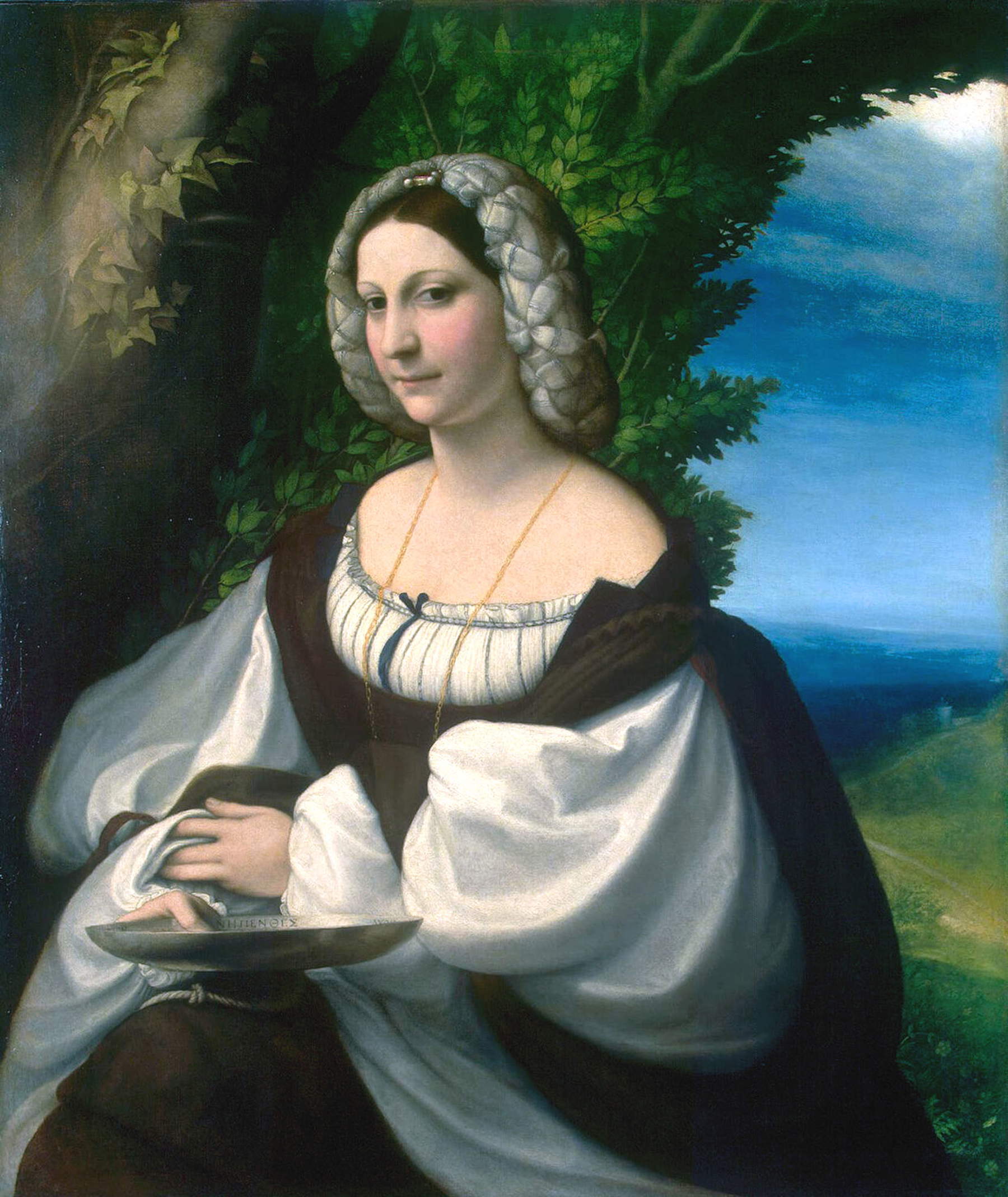 |
| Correggio, Veronica Gambara (1520-1521; oil on canvas, 103 x 87.5 cm; St. Petersburg, Hermitage) With the Mona Lisa, “a work that was never finished,” Leonardo imposed a new set of defining characters in Italian portraiture, among them: the figure seated beyond half, and with hands; the successive twists of the torso and head from the side setting (the sense of life); the soft light that shines on the face, chest and hands (intellect, love, fatality); the enveloping immersion in nature to extreme boundaries, up to the famous atmospheric leaks. Correggio certainly saw the work in Leonardo’s studio in Milan, and in his only portrait he takes up its felicitous setting and particular data. The celebrated poetess, Lady of Correggio by imperial decree, expresses in the painting all her culture, her state of mind, and the progress of her life; the canvas’ much larger measurements reveal its palatial destination, confirmed by the aristocratic and benevolent gaze that responds to her sweet smile. At the height of her face Veronica wanted the name of her beloved painter: Antonius Laetus. |
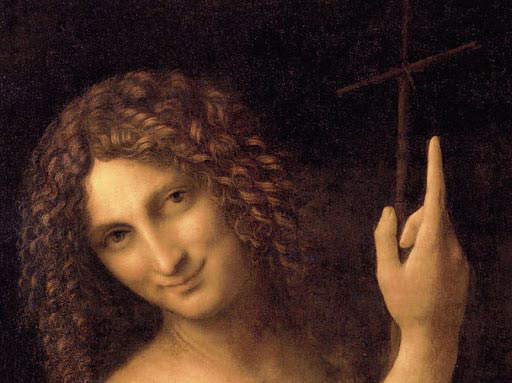 |
| Leonardo, Saint John, detail of the face (oil on walnut panel, 69 x 57 cm; Paris, Louvre) |
 |
| Correggio, Saint Agatha (oil on panel, 29 x 34 cm; Correggio, Private Collection) Leonardo’s teaching in the albeit minimal passages of shadows is carefully confirmed in Correggio by David Alan Brown: this is an important connection concerning the active and selective role of light in paintings. Indeed, Correggio became famous as a master of chiaroscuro, yet without abandoning the evidence and beauty of color. It is an achievement of northern painting that is recognized by the fascinating term “softness.” |
 |
| Leonardo, Spighetta di sonaglini maggiori, viole e fiori di pero (Venice, Accademia Gallery) |
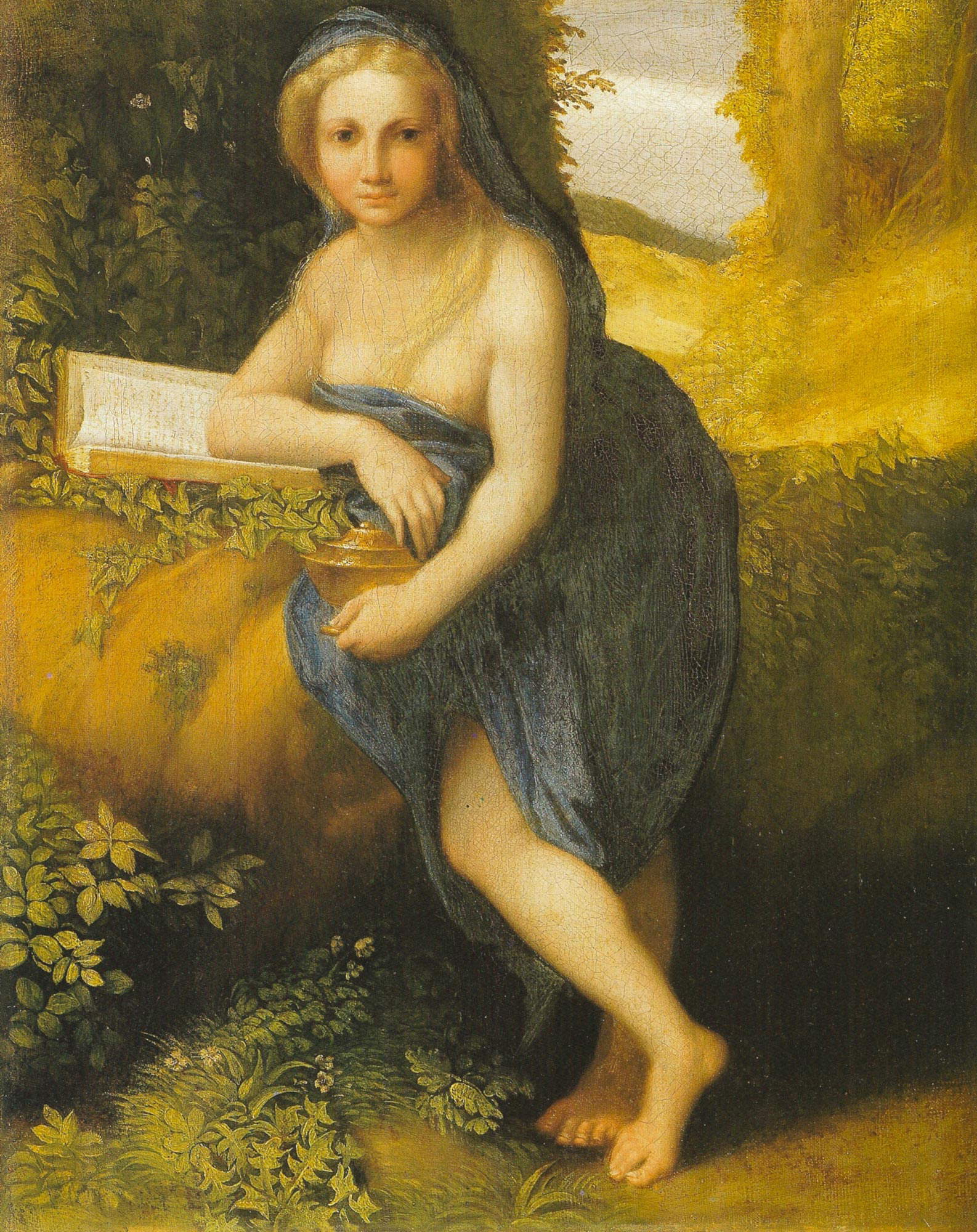 |
| Correggio, Magdalene (1516-1517; oil on canvas, 38 x 30 cm; London, National Gallery) The great Da Vinci, immersed since his childhood in free nature, would never neglect the most acrimonious love and investigation of every aspect of botany in countless definite drawings. For Leonardo says that “to do one must know,” and he considers drawing “more immediate than all words, and than poetry itself.” In an analogy of life and interests, Correggio would always passionately investigate the grasses, shrubs, and plants of his countryside, as in this small painting of Isabellian destination, where a still-florid Magdalene retreats for meditation in a vegetal riot among dandelions, carnations, and climbing ivy. |
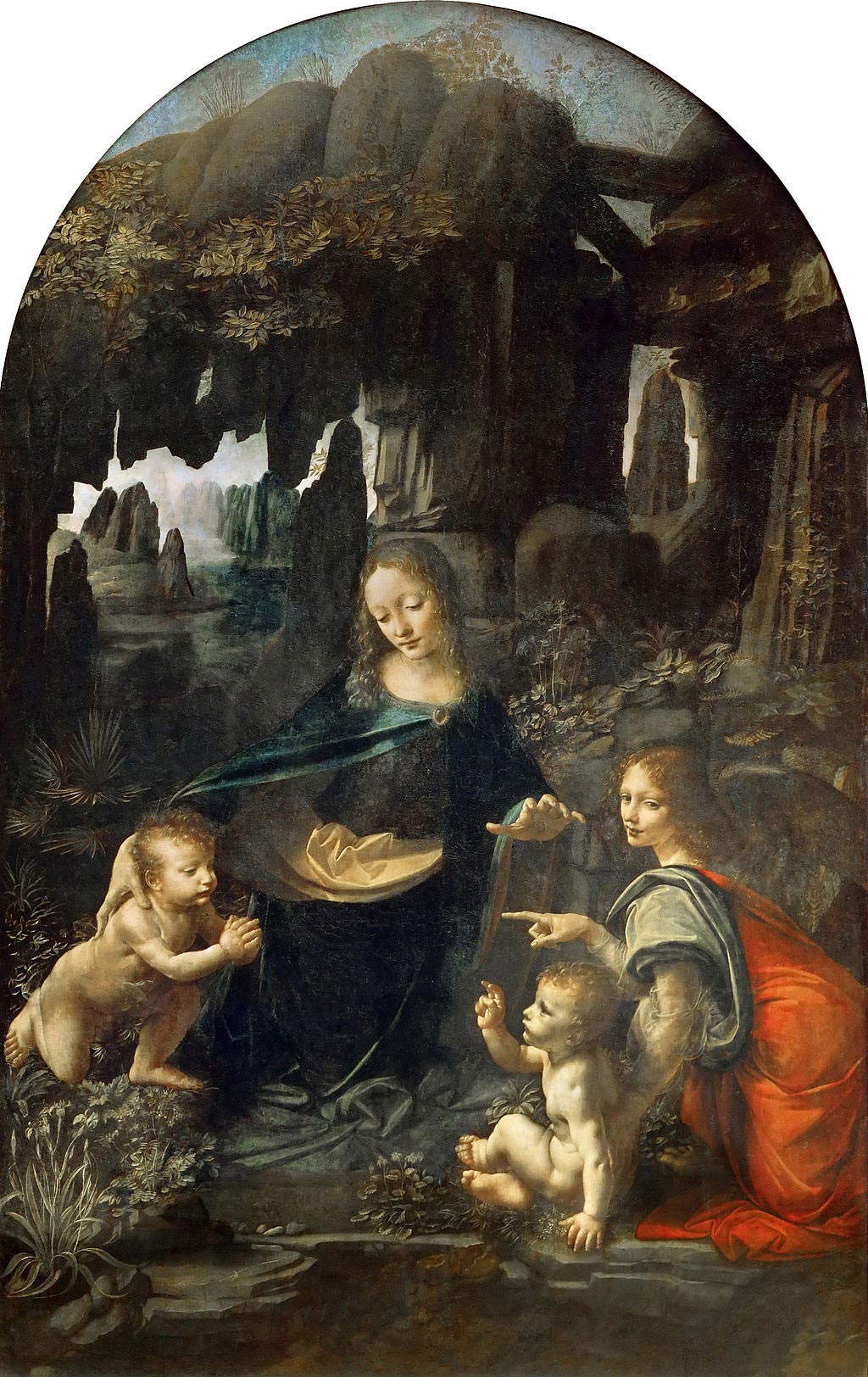 |
| Leonardo, The Virgin of the Rocks (1483-1486; oil now on canvas, 199 x 122 cm; Paris, Louvre) |
 |
| Correggio, Madonna and Child with St. John (oil on panel; 48 x 37 cm; Madrid, Prado) Capable of unexpected originality Leonardo places this bold composition in a “strange place,” symbolic, where every natural element accompanies and clashes with the sacred figures. A freedom that he felt was necessary to pictorial vitality, where waters, rocks and vegetation pose in confrontational tussle with forced lights and large shadows. It is a total naturalistic immersion that holds the telogical references of the Characters. Correggio spontaneously descends into the vertiginous encasement and the humble cavern with “all the sublime of art, of which he is great Master,” as the poetess Gàmbara expresses herself, achieving in this enchanting work the Leonardesque ascendancy certainly admired in Milan. |
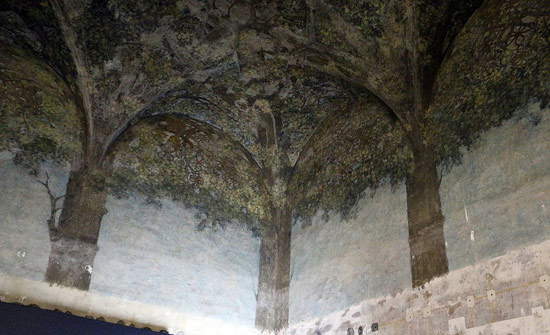 |
| Leonardo, The Room of the Axes, Precarious Drawing now visible (1497-1499; Milan, Castello Sforzesco) |
 |
| Correggio, The Vault of the Camera della Badessa (1518; fresco; Parma, Monastero di San Paolo) With the so-called Sala delle Asse in the Torre Falconiera, between 1497 and 1499, Leonardo attempted a new, grandiose and volitional feat, later almost completely degraded. A trellis of sixteen mulberry trees formed a wide umbrella-shaped plant enclosure, copper-plated toward the sky, thus achieving the transfiguration of an entire environment where imaginary agrarian festivals could ideally be held even in winter. Nicolò da Correggio was no stranger to the idea and the work. The firstling was seized in fullness by Antonio Allegri for the Abbess Giovanna in Parma, where the salon of convivial sapiential encounters truly became a bower of delights. |
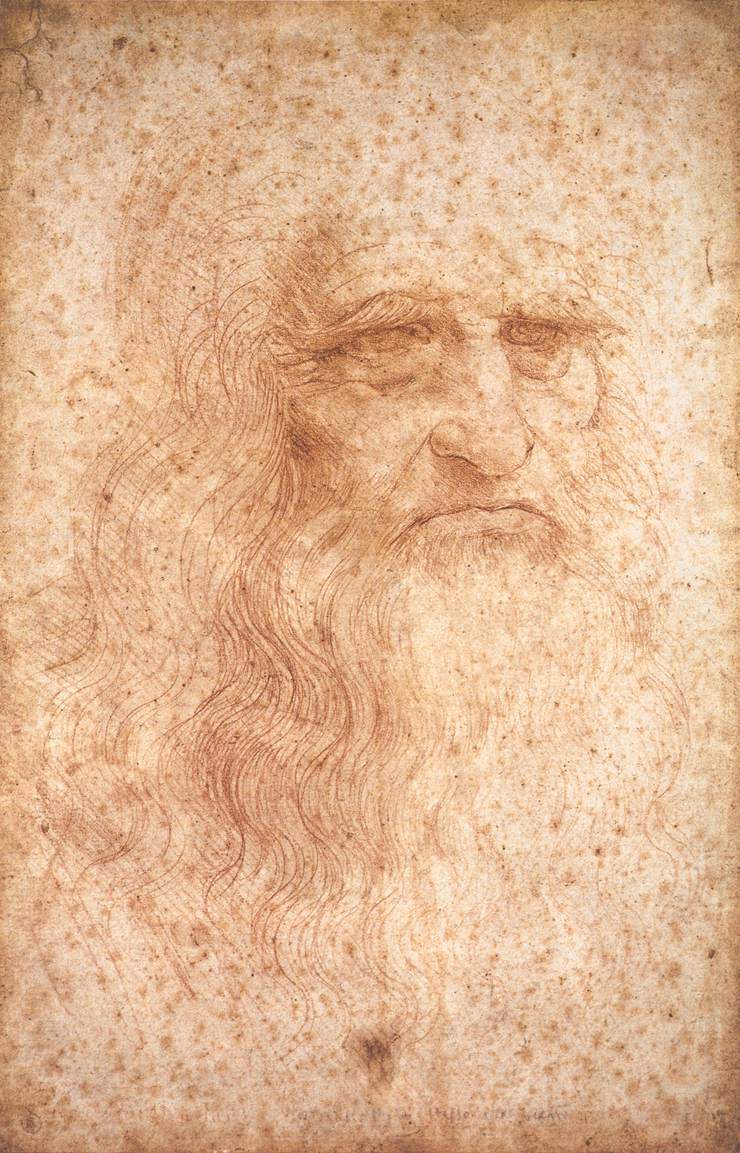 |
| Leonardo, Self-Portrait (c. 1515; sanguine; Turin, Royal Library) |
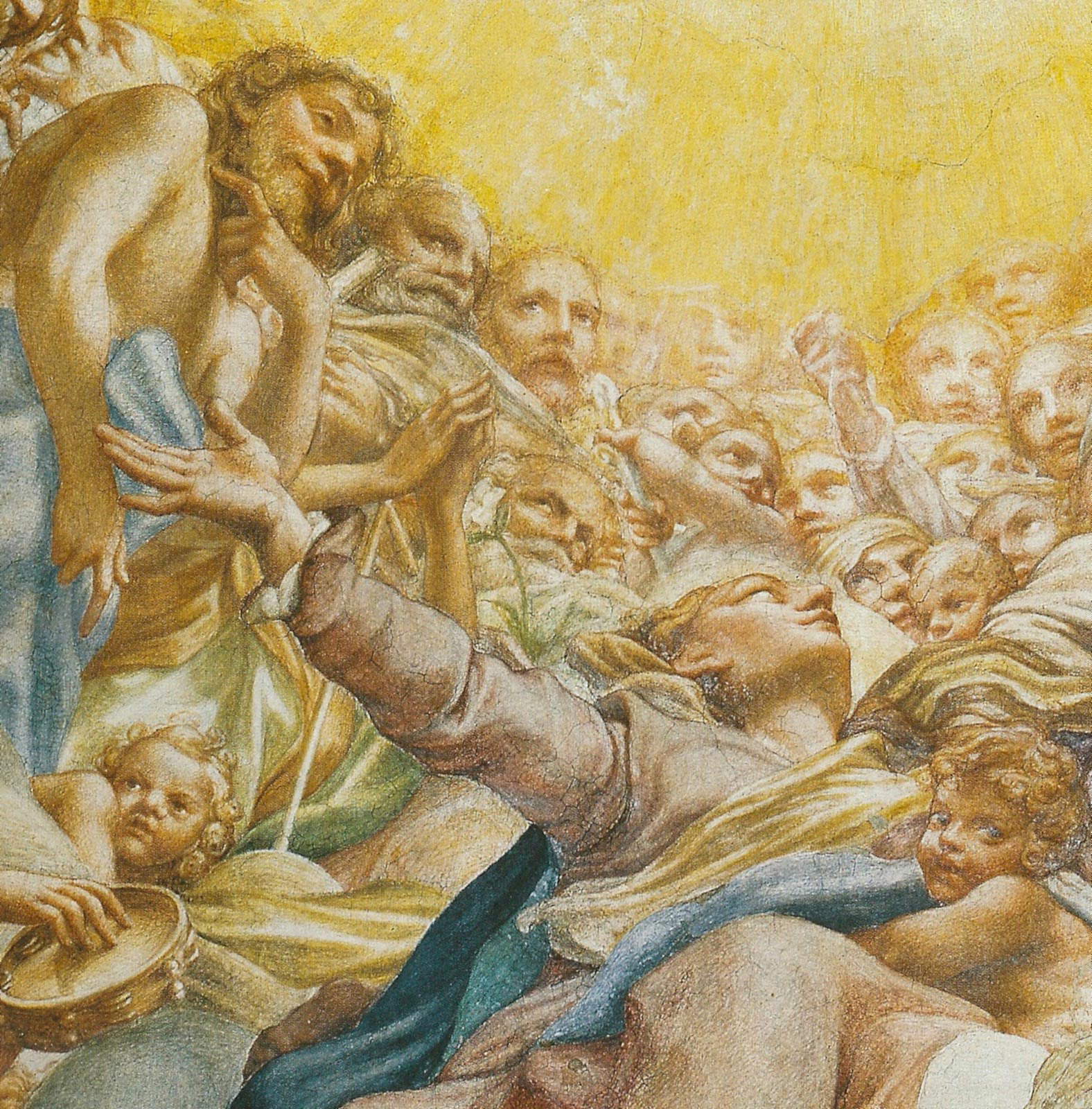 |
| Correggio, Self-Portrait (c. 1531; fresco; Parma, Dome of the Cathedral) With his inscrutable drawing Leonardo, now in exile and toward the end of his life, withdraws into himself, almost contemplating himself in his own mystery. It is a farewell of moving intensity: “if you are alone, you will be all yours”! Differently, Correggio, a choral and hymnic spirit, withdraws like the last of the Peers in Mary’s ascent to heaven, and his gaze opens to the infinite light of the empyrean. |
Warning: the translation into English of the original Italian article was created using automatic tools. We undertake to review all articles, but we do not guarantee the total absence of inaccuracies in the translation due to the program. You can find the original by clicking on the ITA button. If you find any mistake,please contact us.